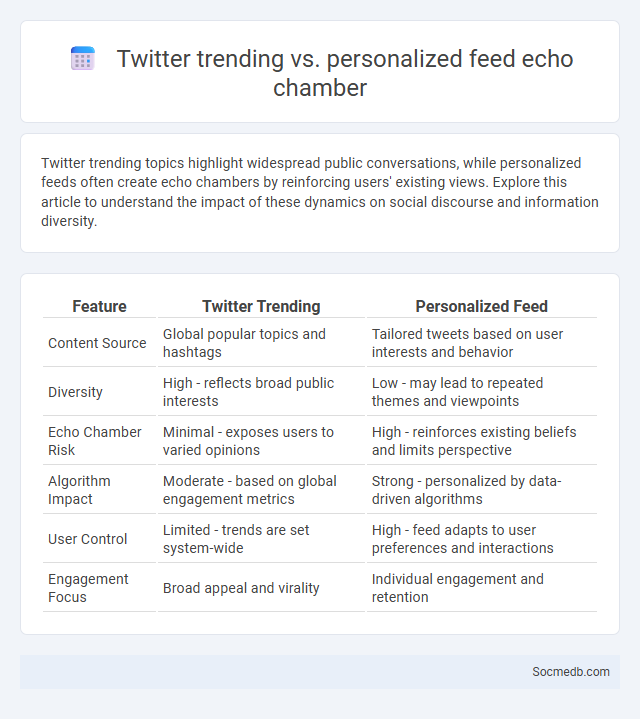
Photo illustration: Twitter trending vs personalized feed echo chamber
Twitter trending topics highlight widespread public conversations, while personalized feeds often create echo chambers by reinforcing users' existing views. Explore this article to understand the impact of these dynamics on social discourse and information diversity.
Table of Comparison
| Feature | Twitter Trending | Personalized Feed |
|---|---|---|
| Content Source | Global popular topics and hashtags | Tailored tweets based on user interests and behavior |
| Diversity | High - reflects broad public interests | Low - may lead to repeated themes and viewpoints |
| Echo Chamber Risk | Minimal - exposes users to varied opinions | High - reinforces existing beliefs and limits perspective |
| Algorithm Impact | Moderate - based on global engagement metrics | Strong - personalized by data-driven algorithms |
| User Control | Limited - trends are set system-wide | High - feed adapts to user preferences and interactions |
| Engagement Focus | Broad appeal and virality | Individual engagement and retention |
Understanding Twitter Trending: A Real-Time Pulse
Twitter Trending topics reflect the real-time pulse of global conversations, capturing the most discussed hashtags and keywords instantly. These trends emerge based on algorithmic analysis of tweet volumes, engagement levels, and geographic relevance, offering insights into what people care about at any moment. By monitoring Twitter Trending, you can stay updated with current events, popular culture shifts, and social movements as they unfold across diverse communities.
Personalized Feeds: Tailoring Content for the Individual
Personalized feeds on social media platforms utilize advanced algorithms and user data such as browsing history, interactions, and preferences to tailor content uniquely for each individual. Machine learning models analyze patterns and predict user interests, optimizing engagement by delivering relevant posts, ads, and recommendations. This customization enhances user experience, increases platform retention rates, and drives targeted advertising efficiency.
The Echo Chamber Effect: What Does It Mean?
The Echo Chamber Effect refers to the phenomenon where social media algorithms amplify your existing beliefs by showing content that aligns with your views, limiting exposure to diverse perspectives. This creates a feedback loop that reinforces opinions and reduces critical thinking, potentially leading to increased polarization. Understanding this effect is crucial for maintaining a balanced and informed outlook in your social media consumption.
Twitter Trending vs. Personalized Feed: Key Differences
Twitter Trending highlights the most popular and widely shared topics globally or within specific regions, offering a snapshot of real-time events and viral content. Your Personalized Feed, on the other hand, curates tweets based on your interests, interactions, and followed accounts, providing a customized experience tailored to your preferences. Understanding the distinction between these features helps you stay informed on broad trends while engaging with content most relevant to you.
How Algorithmic Curation Shapes Our Perspectives
Algorithmic curation on social media platforms uses machine learning to prioritize content that aligns with users' past behavior and preferences, creating personalized feeds. This selective exposure reinforces existing beliefs by amplifying echo chambers and filter bubbles, limiting exposure to diverse viewpoints. As a result, algorithm-driven content delivery profoundly impacts users' perceptions, shaping political opinions, social attitudes, and consumption habits.
Echo Chambers: Causes and Consequences on Social Media
Echo chambers on social media arise from algorithm-driven content personalization, which curates feeds to reinforce users' existing beliefs, limiting exposure to diverse perspectives. This phenomenon intensifies ideological polarization and fosters misinformation spread by creating insulated communities that prioritize consensus over critical discourse. The resulting social fragmentation undermines democratic dialogue and exacerbates societal division.
Is Twitter Trending Creating Diversity or Division?
Twitter's trending topics significantly impact social discourse by amplifying diverse voices and highlighting underrepresented issues, fostering a broader cultural awareness. However, the platform's algorithm can also create echo chambers, intensifying polarization and deepening divisions among users based on ideological lines. Balancing algorithmic transparency and promoting inclusive, fact-based conversations is crucial to harness Twitter's potential for social unity rather than division.
Personalized Feeds and the Risk of Reinforced Bias
Personalized feeds on social media use algorithms to curate content tailored to Your interests, enhancing engagement but often creating echo chambers where similar viewpoints are constantly reinforced. This selective exposure limits diverse perspectives, increasing the risk of cognitive bias and polarized opinions. Understanding this dynamic helps You critically evaluate the information and seek balanced content beyond the algorithmic recommendations.
Combatting Echo Chambers: Strategies and Solutions
Combatting echo chambers on social media requires implementing diverse content algorithms and promoting cross-ideological dialogue to broaden Your perspectives. Utilizing fact-checking tools and encouraging critical thinking helps reduce misinformation spread within homogenous groups. Platforms can enhance transparency and user control over content feed preferences to create more balanced and inclusive online environments.
The Future of Social Media Feeds: Balancing Discovery and Personalization
The future of social media feeds revolves around balancing discovery with personalization by leveraging advanced AI algorithms that analyze user behavior to curate relevant content while introducing novel topics to broaden interests. Emerging technologies like machine learning and natural language processing enable platforms to dynamically adjust feeds, ensuring users receive a mix of familiar favorites and diverse perspectives. This approach aims to enhance user engagement, reduce echo chambers, and create a more meaningful and balanced social media experience.
 socmedb.com
socmedb.com